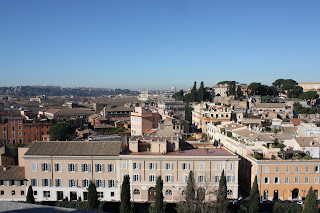And now, all of you get a little history lesson because that's what I get every....single.....day.............
First we went to the Crypta Balbi which is only a few blocks away from studio and is the site for our first project. It was built in the Central Field of Mars during the 1st C. BC and the theater on the site, which was commissioned by Balbus, was the smallest theater in Rome at the time of Augustus.
 |
Reconstruction of what was probably
there but doing so in a very unique way! |
Excavation started in the 1980s and this was the first area in Rome where archaeologists were starting to document and research what happened to the city after the Roman era (Middle Ages, Renaissance, etc.) The museum has many different levels of spaces being excavated but also several levels in the building itself which have exhibits of the history of Rome.
 |
Pieces of the Marble Plan
of Rome (200 AD) |
These were fragments of the marble plan of Rome found in 1961 which dates back to 200 AD. The plan was probably displayed on one of the walls of the Temple of Peace. Only about 10% has been found and the map in its entirety was probably about 2580 sq. ft.
 |
| Mosaic floor tiles in the museum |
Had to take a picture of the mosaic floor for my mom :)
 |
| One of the large pieces of a marble tablet |
During the Middle Ages, this area of the city was starting to fall apart because of abandonment and some new streets were actually able to be cut through some of the ancient public baths. This became very common to create shortcuts through some of the ruins instead of having to go all the way around. The theater commissioned by Balbus also became a fortification during this time.
 |
| Remains of the church from the Renaissance |
A church was also built there in the Middle Ages but was demolished during the Renaissance and replaced by the church of San Lorenzo.
 |
Our crazy professor talking by one of the
marble kilns-he's from Belgium and has
the habit of lecturing with his eyes closed-
really , really entertaining |
Kilns were built so that pieces of marble could be fired and made into lime which could be used in both concrete and brickwork. Historical artifacts did not have as much meaning as they do today so massive statues and ornaments would be thrown into kilns without a second thought.
 |
| Inside the Esedra |
The esedra was part of the original construction of the theater in the late 1st C. BC. It was originally open to the piazza and not walled which occurred in the 2nd C. AD. It was covered with marble and had small niches but later was transformed into a latrine...
 |
| Remains of the latrine... |
In the 5th C. it was used for the production of glass and then in the 6th and 7th C. as a burial ground. In the late 7th C., the esedra and piazza were filled in from debris from the monastery that was demolished but then rebuilt in the 8th C. along with one of the lime kilns. An earthquake in the 9th C. made the southern part of the Colosseum collapse as well the kiln in this complex. Later it was further filled in and built on top of until it was discovered in the 1980s.
 |
| Looking back to the other side of the esedra |
 |
| Pottery found from the 7th C. AD |
This pottery was a very rare find and our professor was very excited about it because there is not much information on medieval Rome during this time. He's currently working on excavating an entire building from the 7th C. Even though most of this pottery was not made in Rome or even in Italy, you can find out where the vessels came from, what was in them and possibly the trade route that was taken during this time just by looking at the vessels and tracking their shape.
__________________________________________________________________________________
Later in the afternoon, we went to visit the Palazzo Altemps Museum with our studio professors. Our next project includes creating an exhibit space in the courtyard of the Crypta Balbi and we came here to find artifacts to exhibit.
 |
| Courtyard of the Palazzo Altemps Museum |
 |
| Fountain with interesting decorations |
 |
Statue with a shaft down the base-not
sure if it was for light or ventilation |
 |
Statue which uses many different types
of colored marble |
 |
| Strip of wall that was still in very good condition |
 |
Massive bust of a woman on a
tiny pedestal-she's actually hollow
in the back to have less weight |
 |
| Dramatic lighting effects |
 |
| No face guy |
 |
I don't know why but I just loved
this guy-he reminded me of some of
the Autobots from Transformers.... |
 |
| Exquisitely painted wooden ceilings |
The museum is a building from the 14th or 15th C. and still has some of the original decorations and frescoes.
 |
| Dress on display |
This museum also had an exhibit of different clothing styles throughout the years. It was interesting to go through the museum looking at both ancient artifacts and different fashion styles over the years.




























































